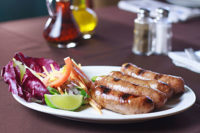
Consumers have had to modify many aspects of their lives over the last two years, and their dining habits have been no exception. More people are preparing meals at home to save on costs, while others have traded down from eating at white-tablecloth restaurants to fast-casual chains.
High-end steakhouses have suffered in particular, as diners aren’t as willing to accept a pricy dinner tab like they used to.
“Our customers have been doing better of late, but in the past two years, we have lost a lot of customers to bankruptcy or closures,” says Douglas Bush, sales manager for Bush Brothers Provisions Co., a West Palm Beach, Fla.-based company. “Independent restaurants fared the worst, especially newer restaurants that hadn’t had the chance to establish themselves. That being said, there were plenty of very old restaurants we saw close their doors as well.”
Bush Brothers, which specializes in hand-cut steaks, caters to white-tablecloth restaurants and upscale hotels, country clubs and healthcare facilities. Bush points out that the company saw a significant upswing in 2010 from 2009, and indications are that the winter season will be even better.
Steaks in general are still popular, and the National Cattlemen’s Beef Association reported an increase in the volume of steaks sold. In the 18 months ending July 25, 2010, there was a 10 percent increase in volume sales at retail for beef middle meats, compared to the previous 18 months.
“Consumers are dining out less and preparing more steaks at home,” says Shelley Bradway, marketing manager for the NCBA. She noted that the price for beef dropped in that time period, and that shoppers took advantage of the good prices. “We think that consumers will continue to purchase steaks and dine at home, to re-create that dining experience that they’ve been enjoying at home.”

Making adjustments
Consumers are not the only people that have made changes in order to adapt to the economy. Restaurants have altered their menus in an attempts to attract customers, and more often than not, they have turned to their protein suppliers for help. Bush says that the economy has led steak suppliers to look to more affordable cuts, in order to help their customers’ bottom lines.“Our customers have come to us looking for steaks like Flat Irons, Top Sirloins and Bavettes, as well as more economical items like Boneless Shortribs to help balance out their menus,” he says. “Some restaurant consumers are still eating their Filet Mignons, but many are turning to more reasonably priced items.”
Restaurants have also added more natural, organic and grass-fed steaks to their menus. Bush says that more customers have been requesting “green” items, but it is still a niche market.
“We have found that ‘all-natural’ items that are birth-to-box antibiotic free, hormone free, high-quality vegetarian-fed like our Creekstone Farms Natural Angus Beef have taken a good hold because they can be price competitive with other quality items,” Bush says. “Grass-fed and organic options are definitely more popular now than ever, but their share of the market is restricted due to extremely high price points.”




Report Abusive Comment